
David Koeberlein, director of advanced engineering for Cummins and principal investigator on the SuperTruck project, says the prototype tractor-trailer uses exhaust heat that would otherwise be wasted to help power the crankshaft. (All photos courtesy ORNL/Genevieve Martin unless indicated otherwise)
Note: This story was last updated at 2 p.m.
Tractor-trailer prototype uses probe developed by ORNL for better gas mileage, cleaner exhaust
It’s a sleek, aerodynamic freight-hauling machine. With its wide tires, rounded edges, and body parts that hug the ground, this million-dollar prototype looks like it could be at home on a race track.
It’s already achieved celebrity status, serving as the backdrop for President Barack Obama during a February speech on greenhouse gas emissions and fuel efficiency standards.
But the SuperTruck is more likely to end up hauling meat and potatoes from Boise to Boston.

The fuel-efficient SuperTruck, the result of a four-year collaboration between the trucking industry and the federal government, made a pit stop at Oak Ridge National Laboratory on Tuesday.
Still, researchers have reason to celebrate. On Tuesday, they said the high-tech tractor-trailer has increased fuel efficiency by 75 percent. Fully loaded, the SuperTruck can drive 10.7 miles on a gallon of gas. That compares to an industry average of 5.8 to 6.5 miles per gallon.
“This is a really big deal,” said Claus Daniel, deputy director of sustainable transportation projects at Oak Ridge National Laboratory, where the SuperTruck made a pit stop on Tuesday.
It’s the result of a collaboration between the trucking industry and the U.S. Department of Energy. It’s not clear how soon the new technologies tested in the Cummins/Peterbilt tractor-trailer, which was built in Denton, Texas, will show up on the nation’s highways.
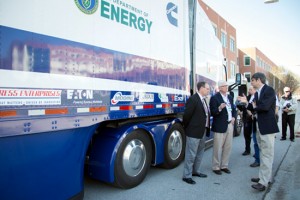
Principal Investigator David Koeberlein of engine manufacturer Cummins, left, and ORNL Director Thom Mason discuss the SuperTruck’s features with reporter Frank Munger of the Knoxville News Sentinel.
“You probably won’t see a SuperTruck on the road tomorrow,” said Bill Partridge, ORNL’s principal investigator on the project. “But I think you’ll see elements of it.”
Researchers tested improvements on the engine, chassis, and body, said David Koeberlein, director of advanced engineering for Cummins in Columbus, Ind., and the project’s principal investigator. The new components include systems that recycle exhaust heat to help power the crankshaft, magnesium cross members that are lighter than aluminum, and aerodynamic fairings, skirts, and “boat tails.”
“It’s designed like a race car in terms of aerodynamics,” Daniel said.
“We’re literally taking exhaust heat from the engine that would be wasted and taking it straight to the crankshaft,” Koeberlein said of the waste heat recovery system.
Other features include a reduced vehicle weight, an air gap between the tractor and trailer that is as narrow as a few inches, GPS cruise control, idle reduction, ceramic brake drums, a single drive axle, route planner, and lithium-ion battery pack for use during overnight operations.
The “boat tails” on the back of trailer extend out at horizontal and vertical angles, forming a partial tent-like structure over the trailer doors. Skirts draped from the sides of the trailer can be lowered for aerodynamic efficiency and raised for in-city driving to allow drivers to hop curbs.
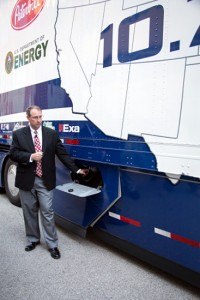
Skirts that drape from the sides of the trailer can be lowered to improve aerodynamic efficiency and raised to allow drivers to hop curbs.
The truck also has variable-thickness body rails, rim covers, a tractor frame that is 18” shorter than normal, and a diesel particulate filter that allows exhaust to be vented out near ground level with no soot.
ORNL research contributed to the 75 percent fuel economy increase through a laser-based diagnostic probe. It samples carbon dioxide in the engine’s intake system to help ensure that recirculated exhaust gas is mixed uniformly.
“The rapid speed and sensitive measurement by ORNL’s probe enabled Cummins to optimize their engine for improved fuel economy and cleaner exhaust,” the lab said.
Daniel said the engine has a thermal efficiency of more than 51 percent, compared to about 42 percent for the typical truck. Researchers were able to increase the vehicle’s freight efficiency—measured in ton-miles per gallon—by 86 percent, meaning they almost doubled it, Daniel said.
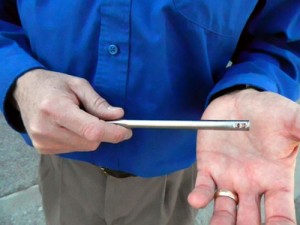
Bill Partridge, ORNL’s principal investigator, holds the laser diode-based probe that the lab developed to sample carbon dioxide in the engine’s intake system to help ensure recirculated exhaust gases are mixed uniformly. (Photo by John Huotari)
The SuperTruck program has a total cost of about $78 million. Cummins, Peterbilt, and their partners invested $38.8 million during a four-year period, and DOE’s Vehicle Technologies Office awarded matching grants. Other SuperTruck partners include Modine, U.S. Xpress, Eaton, Bergstrom, Goodyear, and Purdue University.
“The idea is that this will go into regular production at some point,” Daniel said.
The SuperTruck could help in the nation’s quest to increase its energy independence and reduce greenhouse gas emissions from trucks by 43 percent. Researchers said commercial trucks make up only 4 percent of the vehicles on the road, but they use 25 percent of the fuel consumed in the United States.
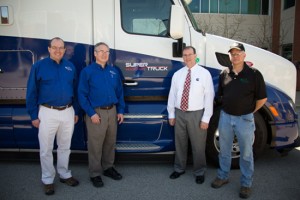
Partridge is pictured second from left and Koeberlein is second from right. At left is Jim Parks, ORNL group leader for the Emissions and Catalysis Research Group. At right is truck driver A.J. Allen of Real World Testing.
DOE expects a high adoption rate. Officials said each truck driver could save about 5,000 gallons of fuel and up to $35,000 per year if they drive about 120,000 miles. If adopted across the trucking industry, the improvements could reduce oil consumption by almost 300 million barrels per year and fuel costs by about $30 billion, DOE said.
“It’s a huge amount of savings,” Koeberlein said.
***
Here are four more pictures:
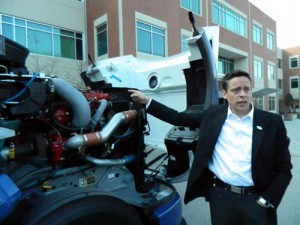
Claus Daniel, deputy director of ORNL’s Sustainable Transportation Program, says the prototype tractor-trailer has dramatically increased fuel efficiency to 10.7 miles per gallon. (Photo by John Huotari)
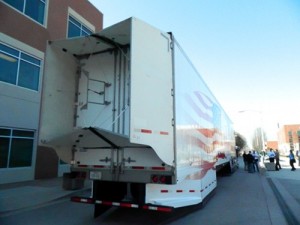
A “boat tail” on the back of the SuperTruck helps improve aerodynamic efficiency. (Photo by John Huotari)
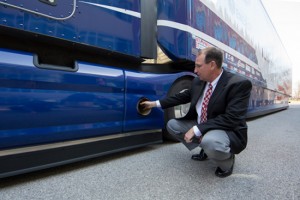
The engine exhaust from the SuperTruck is vented out near ground level. It’s soot-free because of a diesel particulate filter.
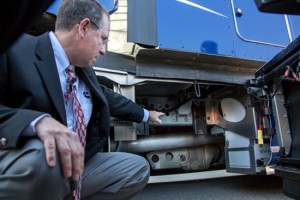
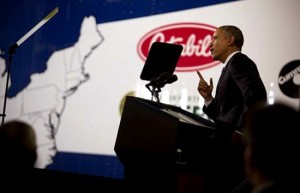
Leave a Reply